Table of Contents
Mofongo: 7 Incredible Reasons It’s the Best Caribbean Dish
Mofongo, a quintessential Puerto Rican dish, has captured the hearts and palates of many with its rich flavors and cultural significance. This savory concoction, primarily made from fried green plantains, reflects the island’s diverse heritage and culinary traditions. In this comprehensive guide, we’ll delve deep into the origins, ingredients, preparation methods, and variations of mofongo, offering readers a thorough understanding of this iconic dish.
The Roots of Mofongo: A Culinary Journey Through Time
Mofongo’s origins trace back to a fusion of African, Taíno, and Spanish influences, mirroring Puerto Rico’s diverse cultural tapestry. The dish is believed to have evolved from West African fufu, a starchy side made by pounding boiled yams, plantains, or cassava. Enslaved Africans brought this culinary tradition to the Caribbean, where it intertwined with local ingredients and cooking techniques.
Essential Ingredients
Discovering the core elements behind mofongo reveals why this dish is so deeply loved and widely prepared.
The Star of the Show: Green Plantains
If there’s one ingredient that absolutely defines mofongo, it’s green plantains. These starchy, unripe bananas are the backbone of the dish, giving it that dense, hearty texture and mild, savory flavor. Unlike ripe plantains, which are sweet, green plantains fry up golden and crisp, perfect for mashing into that signature mofongo base.
To prepare them, they’re peeled, sliced, and deep-fried until slightly golden. The goal is to soften them up while still holding enough structure for a good, chunky mash.
Flavor Powerhouses: Garlic and Olive Oil
What’s mofongo without that irresistible garlicky punch? Fresh garlic cloves are typically crushed and blended with olive oil to create a deeply flavorful paste. This not only brings a burst of bold taste but also moistens the mashed plantains, ensuring each bite is rich and savory.
In many recipes, the garlic paste is worked right into the plantain mash, infusing it throughout. In others, it’s drizzled on top as a finishing touch. Either way, garlic is the heartbeat of mofongo’s flavor.
The Role of Broth: Adding Moisture and Depth
Nobody wants dry mofongo, right? That’s where broth steps in. Whether it’s chicken, beef, or vegetable, a bit of warm broth gets stirred into the mixture to soften the plantains and tie all those intense flavors together.
Pro tip: Use a homemade broth when possible. The richness it adds is off the charts!
Optional Additions: Proteins and Extras
While traditional mofongo keeps things simple, you’ll often find popular add-ins to take it to the next level, like:
- Shredded chicken
- Juicy shrimp
- Tender steak
- Sautéed vegetables
Learn more about the nutritional value of plantains — you’ll be surprised how healthy this dish can be!
What Makes Mofongo Truly Special?
It’s the balance. The crispy yet tender plantains. The aromatic garlic. The savory splash of broth. And of course, those optional toppings that push it over the top. When these ingredients come together, mofongo becomes more than just food — it’s an experience.
Step-by-Step Guide to Making Mofongo at Home
Mastering the technique of preparing mofongo from scratch is easier than you might think, and we’ll walk you through each essential step.
Step 1: Preparing the Plantains
The first step in crafting perfect mofongo is selecting the right plantains. You’ll need green plantains, which are firm and starchy, not the yellow or black ones that are sweet.
- Peel the Plantains: Cut off both ends of the plantain, then score the skin lengthwise in two or three spots. Carefully peel the skin away from the flesh, revealing the green plantain inside.
- Slice the Plantains: Slice the peeled plantains into 1-inch thick rounds. You can also cut them into diagonal slices, which allows them to fry evenly and become crispy on the outside.
Tip: If you’re struggling to peel the plantains, you can soak them in warm water for a few minutes to soften the skin.
Step 2: Frying the Plantains
Once your plantains are ready, it’s time to fry them. Here’s how you do it:
- Heat the Oil: Pour enough vegetable oil into a pan to submerge the plantain slices (about 2-3 inches). Heat the oil over medium-high heat until it reaches around 350°F (175°C).
- Fry the Plantains: Carefully add the plantain slices into the hot oil. Fry them for about 3-4 minutes on each side, or until they turn golden brown and crispy.
- Drain the Plantains: Remove the plantains from the oil and drain them on a paper towel to remove excess oil.
Pro Tip: Fry the plantains in batches to ensure they cook evenly and don’t overcrowd the pan.
Step 3: Making the Garlic Oil
While your plantains are frying, you’ll want to prepare the essential flavor base — the garlic oil. Here’s how:
- Prepare the Garlic: Peel and finely chop about 4-6 garlic cloves.
- Heat the Oil: In a small skillet, heat about 2 tablespoons of olive oil over medium heat.
- Infuse the Garlic: Once the oil is hot, add the garlic and sauté for about 1-2 minutes, until fragrant. Be careful not to burn it — you just want to infuse the oil with that garlic goodness.
Step 4: Mashing the Plantains
Now it’s time for the fun part — mashing!
- Mash the Fried Plantains: Using a mortar and pestle (traditional!) or a large bowl and a potato masher, begin mashing the fried plantains. Add the garlic oil bit by bit to ensure the mash stays moist and flavorful.
- Add Broth: Gradually pour in a little bit of warm chicken or vegetable broth to help mash the plantains into a smooth, slightly chunky consistency. Be careful not to add too much liquid — you want the mofongo to hold its shape, not turn into a mushy paste.
- Season: Add salt and pepper to taste, and feel free to sprinkle a little extra garlic or parsley if you like a more intense flavor.
Step 5: Molding and Serving
Once your plantains are perfectly mashed and seasoned, it’s time to mold and serve them!
- Form the Mofongo: You can either mold the mofongo into small individual servings by pressing it into a bowl or plate, or you can serve it as a large mound in the center of a platter.
- Serve with Protein: Traditionally, mofongo is served with savory meats like shrimp, chicken, or pork, but feel free to top it with whatever you prefer — grilled steak, sautéed vegetables, or a delicious sauce!

Serving tip: For that extra flair, drizzle some more garlic oil or broth over the top to keep it moist and flavorful.
Creative Variations
Vegetarian Mofongo: Plantains and Veggies Unite
If you’re seeking a meatless alternative, vegetarian mofongo offers a flavorful and hearty option. By using a variety of sautéed vegetables and a rich vegetable broth, you can easily create a satisfying version of this dish.
- Sauté the Vegetables: Choose a mix of your favorite vegetables, such as bell peppers, onions, tomatoes, and zucchini. Sauté them in olive oil with garlic and a pinch of paprika for extra depth of flavor.
- Combine with Mofongo: Once your vegetables are tender, fold them into the mashed plantains along with the garlic oil and vegetable broth.
- Serve: Mold your vegetarian mofongo into a mound and garnish with fresh herbs, such as parsley or cilantro.
Mofongo with Pork (Traditional Puerto Rican Style)
For a truly authentic experience, mofongo with pork is a must-try. In Puerto Rican cuisine, mofongo is often paired with crispy lechón (roast pork) for a deliciously indulgent meal.
- Prepare the Pork: Roast your pork shoulder or pork belly until crispy, seasoned with garlic, oregano, and a bit of cumin for that classic Puerto Rican flavor.
- Combine with Mofongo: Serve the crispy, flavorful pork on top of a hearty serving of mofongo.
- Drizzle the Juices: Don’t forget to drizzle the pork juices or a bit of the garlic oil over the mofongo to keep it juicy and flavorful.
This dish is a carnivore’s dream and an absolute staple in Puerto Rican cuisine. Perfect for a celebratory feast!
Mofongo with Chicken: A Comforting Classic

Another beloved version of mofongo is the chicken mofongo, which strikes the perfect balance of comfort and bold flavors. Whether you’re using grilled, fried, or rotisserie chicken, it’s sure to pair wonderfully with the mashed plantains.
- Prepare the Chicken: Cook your chicken to your preference — grilled or fried, with a marinade of garlic, lime, and your favorite spices.
- Combine: Serve the chicken on top of your mofongo, adding a drizzle of the garlic oil or broth to keep everything moist and full of flavor.
- Garnish: Garnish with extra herbs and a squeeze of lime to elevate the dish further.
This variation is perfect for weeknight dinners or casual gatherings with friends and family.
Mofongo with Cheese: A Cheesy Delight
For all the cheese lovers out there, mofongo with cheese is a rich and creamy variation that adds a luscious twist to the dish. By incorporating your favorite cheese (like mozzarella or cheddar) into the mashed plantains, you’ll add a gooey, melty element that’s hard to resist.
- Mix in the Cheese: After mashing the plantains with garlic oil and broth, fold in a generous amount of grated cheese.
- Serve: Mold the cheesy mofongo into a mound and top it with more cheese for an indulgent, cheesy experience.
- Add a Protein: For an even richer experience, serve it with grilled chicken, steak, or shrimp.
Frequently Asked Questions About Mofongo
In this section, we’ll answer some of the most frequently asked questions about mofongo to help you perfect your recipe and learn more about the dish.
What is Mofongo Made Of?
Mofongo is traditionally made of green plantains, which are peeled, fried, mashed, and then mixed with garlic, olive oil, and broth. The mashed plantains are often molded into a mound or served in a bowl, and are typically accompanied by a protein like shrimp, chicken, or pork. The garlic-infused oil gives mofongo its signature savory and aromatic flavor.
Can I Use Yellow Plantains for Mofongo?
While yellow plantains are sweeter and softer than green plantains, they are not ideal for traditional mofongo. The texture and flavor are too soft and sweet to create the signature savory, chunky texture of mofongo. Stick to green plantains for the best results.
Tip: If you have only yellow plantains available, you can still use them for a sweeter, dessert-style mofongo, but it will be a different dish altogether.
How Do I Serve Mofongo?
Mofongo can be served as a side dish or as the main course. It’s most commonly served with a variety of proteins, such as shrimp, chicken, pork, or beef. It’s also often paired with a flavorful broth or sauce to keep it moist.
You can either mold the mofongo into individual servings or serve it as a large mound in the center of the plate. Garnish with herbs like cilantro or parsley for a fresh touch.
Can I Make Mofongo Ahead of Time?
Yes, you can make mofongo ahead of time! Simply prepare the mashed plantains, let them cool, and then store them in an airtight container in the refrigerator for up to 2 days. To reheat, warm the mofongo on the stovetop with a little bit of broth or garlic oil to restore its moisture and texture.
Tip: If you plan to make mofongo ahead of time, it’s best to store the garlic oil and broth separately so they stay fresh and flavorful when you reheat the dish.
What Can I Substitute for Garlic Oil in Mofongo?
If you don’t have garlic oil on hand, you can easily make your own by sautéing minced garlic in olive oil until it becomes fragrant. Alternatively, you can use plain olive oil or vegetable oil, but the flavor won’t be as robust. If you prefer, you can also use butter for a richer taste, but garlic oil is the traditional option.
Can Mofongo Be Made Vegan or Vegetarian?
Yes! You can easily make mofongo vegan or vegetarian by omitting animal-based broths and proteins. Simply use vegetable broth and substitute the meat with tofu, tempeh, or a variety of sautéed vegetables. You can also add plant-based cheese if you’d like a cheesy twist to your dish.
What’s the Difference Between Mofongo and Tostones?
Both mofongo and tostones are made from plantains, but they are prepared differently. Tostones are twice-fried plantains, resulting in crispy, crunchy pieces. Mofongo, on the other hand, involves frying plantains, mashing them, and mixing them with flavorful ingredients like garlic, oil, and broth.
While tostones are served as a snack or appetizer, mofongo is often a more substantial dish, typically served as a side or main course with meats and sauces.

